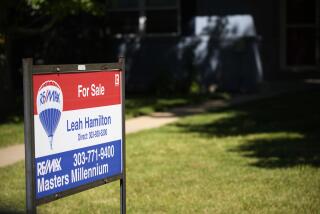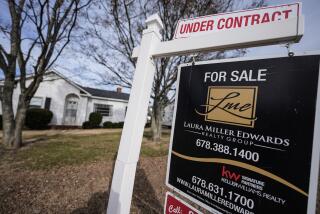INSIDE REAL ESTATE : How Top Agents Sell in Slow Market : Sales: Although some realtors expect to equal ’89 income this year, they say they’ll have to work harder, use innovative sales tools.
- Share via
Earlier this year realtor Bruce Mosk printed “Open House” on a helium blimp the length of two cars and floated it above one of his listings in Northridge.
“I couldn’t get people (into) the property,” explained Mosk, who sold more than $15 million in homes last year for Mike Glickman Realty’s Woodland Hills office. The blimp worked, tripling the number of visitors at Mosk’s open house.
Although many realtors haven’t tried blimps, most Southland agents are looking for ways to find buyers in a market with too many homes for sale.
An open house for agents now often includes food to get attendance up. Some realtors use flyers with color pictures of the home in hopes that potential buyers will remember what they’ve seen.
Mosk has also used a soap bubble machine, just like Lawrence Welk’s, to get passing traffic to slow down. “You’re not going to miss my open house,” he said.
Gone are the heady days of 1988, when homes “sold in three days with multiple offers,” said John Valentine, who sold $17 million in homes last year for Pasadena’s Herbert Hawkins Realtors.
But top agents report that the cost of selling homes has risen drastically. W. Darrow Fiedler, who sold $20 million in 1989 for Re/Max Beach Cities, now spends 25% of his commissions on advertising to get homes sold.
Two years ago, he “didn’t have to spend anything” on advertising, Fiedler said. But as the housing market softened in the last six months of 1989, his marketing costs went up.
Figures compiled by the California Assn. of Realtors (CAR) show that sales activity in the Los Angeles area dropped 12.8% last year from 1988. Orange County reported a 16.8% sales decline, while the state as a whole went down 4.2%.
“The frenzied buyers of ’88 have become the very cautious buyers of ‘90,” said Betty Cristiano. She sold $14 million last year for Fullerton’s Realty World-Eisner & Associates, making her one of the top two agents nationally for the franchise.
But for experienced realtors, these conditions aren’t unexpected. “If you want to know the truth,” Cristiano said, “this is kind of a normal market.”
That comes as a shock to quite a few Los Angeles area realtors and homeowners, many of whom expect housing appreciation rates to be in double digits every year.
But the real estate market advances unevenly. The CAR says price gains in the Los Angeles area went from 8.4% in 1985-86 to more than 21% during each of the next two years. In other words, a home that cost $150,000 in 1986 sold for $220,000 in 1988.
However, Valentine noted that prices “cannot continually go up and surpass people’s incomes.” Today we’re halfway through what might be a two-year slump, according to some realtors.
“This type of market isn’t a time to start in real estate,” said Cristiano, who has been an agent for 18 years.
However, no one told that to June Oh. Last year she was the top rookie for Fred Sands Realtors. Oh sold a total of $8 million in homes, even though she didn’t start working at Sands’ West Los Angeles office until April.
Company officials expect her to sell almost twice that amount in 1990, putting her “in the top 1%” of the firm’s agents.
Oh tries to develop a personal relationship between buyers and sellers to keep problems from coming up during the transaction. Oh works mainly with buyers, and if she sees fishing poles in the garages of both her client and the seller, she will get them swapping fish stories.
Helping the sellers feel “proud of their house” makes the deal go easier. “It’s not just merchandise,” Oh said.
In today’s market, sellers are interviewing as many as eight realtors before listing, Cristiano said. Sellers want to “see which one will spend money and work hard enough to get the house sold.”
Despite these conditions, most top realtors believe they can do as well this year as they did in 1989. For them, that means earning at least $400,000 in commissions.
Today they have past clients to call on, marketing systems in place and experience that can get them through a slow market without hurting their income.
“A lot of top agents wish for bad markets,” said Walter Sanford, who sold $48 million in homes during 1989 through his Sanford Group Inc.
Even though phone calls into his Long Beach office are down 50% from last year, Sanford anticipates good listings will become easier to get as realtors leave the business.
“We could lose as many as 30% of (all) agents in the next 18 months if things continue,” he said.
“Now it’s actually a business. You have to market properly.”
He has 11 staff members who write and call expired listings, homes for rent and “for sale by owners” to solicit listings.
More aggressive marketing helps agents compete for fewer buyers. Beverly Hills Jon Douglas Co. “has formed new affiliations” with Japanese real estate brokerage firms and New York’s Sotheby fine art auction house “to reach out and look for buyers,” said John Aaroe.
As manager of Douglas’ “estates division,” Aaroe sold about $45 million in homes valued at a minimum of $1 million in 1989.
Mosk sends out 20,000 pieces of mail every month, keeping his office’s three computers, two photocopiers and two labeling machines busy.
But many agents can’t afford such efforts. In fact, some are working out of their homes instead of paying for the overhead of an office, Fiedler notes. Walk-in business and calls in response to advertising “have disappeared,” he said.
Yet, top agents are stepping up promotional efforts. For instance, Mosk now prints at least 500 four-color brochures for each of his listings.
Because so many other agents offer similar flyers, Mosk believes he has to print his in color. “If a buyer is looking at 25 to 30 brochures, he will be attracted to mine,” Mosk reasons.
Prospective buyers can gather that many flyers while looking at the “swarms and swarms of listings coming on the market,” Valentine said.
Cristiano noted that during 1988 only about half a dozen Fullerton homes priced from $300,000 to $350,000 would be listed at any time. Yet recently she found 90 for sale in that price range.
With more properties on the market, only owners who are willing to lower their prices are finding buyers. Aaroe notes that prospective buyers “won’t come to look” at a home if the asking price is more than 15% above what it’s worth.
Because of the effort and expense needed to sell homes now, most experienced agents won’t take listings that aren’t priced realistically.
And because buyers know “they can negotiate for a month if they want to,” Fiedler said agents must work harder to make deals happen. He said he’s putting in about 10 more hours a week than last year to make the same amount of money.
Other agents use methods that don’t demand longer hours.
For instance, Mosk bought a full-size slot machine in Las Vegas and had it adapted to accept tokens. He brings the slot machine to open houses for brokers and gives them tokens for looking at the house. A chance to win prizes encourages brokers to visit the house.
However, Mosk remarked, “I didn’t have to do this eight months ago.”
But conditions now are “totally a buyer’s market,” Valentine said. Top-producing realtors take their cues from this fact. Cristiano, for instance, suggests that buyers make low offers to “find someone who’s motivated to sell.”
She would encourage a buyer who can afford a $180,000 to $185,000 home to offer that amount on five homes priced at $200,000. Today, there’s a good chance one of those offers will be accepted.
“We don’t make this market,” Valentine noted, “but we do understand it.”
TIPS FROM TOP-SELLING REALTORS
Here are tips from the some top-selling realtors on buying or selling a home now.
Advice for sellers:
* Forget about 1988. If you want to sell for what neighbors got back then, you’ll have to wait a few years.
* Choose an agent carefully. Find out what specific measures will be taken to sell your home.
* Make sure your agent knows your time frame. If you need to sell quickly, more drastic price cuts will be required.
* Quickly fix any “negatives,” such as poor landscaping, mentioned by agents who show your home.
* Be flexible when negotiating with buyers. Even while sales are in escrow, buyers are asking sellers for concessions.
Advice for buyers:
* Don’t wait for prices to drop much further. No one knows when the market will change.
* Know what you want and can afford and focus your efforts on homes fitting your needs.
* Take your time and look at the many houses on the market today.
* Try to strike a good deal. Some sellers need to move quickly, and thus are very motivated to sell.
* Be prepared to negotiate. Most sellers will drop prices only so far, so be prepared for a counteroffer.
More to Read
Inside the business of entertainment
The Wide Shot brings you news, analysis and insights on everything from streaming wars to production — and what it all means for the future.
You may occasionally receive promotional content from the Los Angeles Times.










